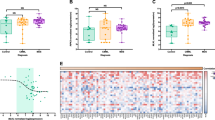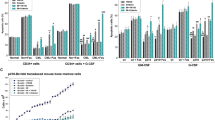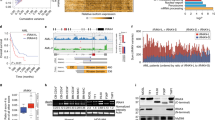Abstract
Several apoptosis-inducing systems, including Fas/Fas ligand and TNF-related apoptosis-inducing ligand (TRAIL) and its receptors, are upregulated in myelodysplastic syndrome (MDS). FLIP (FLICE (FAS-associated death-domain-like IL-1β-converting enzyme)-inhibitory protein)) was identified as an inhibitor of FAS and TRAIL signals. Here, we characterized FLIPLong (FLIPL) and FLIPShort (FLIPS) expression in bone marrow mononuclear cells (BMMNCs) and in CD34+ cells of 29 MDS patients, and in 17 normal volunteers. The expression was correlated with apoptotic indices. In CD34+ cells, FLIPL levels were higher among normal individuals than in MDS patients (P=0.04). Among total BMMNC, FLIPL levels also tended to be higher in normal subjects than in MDS patients, although this difference was not significant (P=0.71). FLIPL levels in CD34+ cells were negatively correlated with apoptosis in both normal and MDS marrows (P=0.03). FLIPShort RNA expression was higher in MDS patients than in normal controls in both BMMNC (P=0.03) and CD34+ cells (P=0.08). In contrast to FLIPL, FLIPSt levels were positively correlated with apoptosis. At the protein level FLIP was most readily detectable in patients with high blast counts. The data suggest that FLIPL and FLIPS are differentially regulated, and that the relative levels of both isoforms play a role in the regulation of apoptosis in MDS.
This is a preview of subscription content, access via your institution
Access options
Subscribe to this journal
Receive 12 print issues and online access
$259.00 per year
only $21.58 per issue
Buy this article
- Purchase on Springer Link
- Instant access to full article PDF
Prices may be subject to local taxes which are calculated during checkout



Similar content being viewed by others
References
Nagata S . Apoptosis by death factor. Cell 1997; 88: 355–365.
Parker JE, Mufti GJ . Excessive apoptosis in low risk myelodysplastic syndromes (MDS) [Review]. Leukemia Lymphoma 2000; 40: 1–24.
Raza A, Gezer S, Mundle S, Gao XZ, Alvi S, Borok R et al. Apoptosis in bone marrow biopsy samples involving stromal and hematopoietic cells in 50 patients with myelodysplastic syndromes. Blood 1995; 86: 268–276.
Bouscary D, De Vos J, Guesnu M, Jondeau K, Viguier F, Melle J et al. Fas/Apo-1 (CD95) expression and apoptosis in patients with myelodysplastic syndromes. Leukemia 1997; 11: 839–845.
Shetty V, Hussaini S, Broady-Robinson L, Allampallam K, Mundle S, Borok R et al. Intramedullary apoptosis of hematopoietic cells in myelodysplastic syndrome patients can be massive: apoptotic cells recovered from high-density fraction of bone marrow aspirates. Blood 2000; 96: 1388–1392.
Parker JE, Mufti GJ, Rasool F, Mijovic A, Devereux S, Pagliuca A . The role of apoptosis, proliferation, and the Bcl-2-related proteins in the myelodysplastic syndromes and acute myeloid leukemia secondary to MDS. Blood 2000; 96: 3932–3938.
Ashkenazi A . Targeting death and decoy receptors of the tumour-necrosis factor superfamily [Review]. Nat Rev Cancer 2002; 2: 420–430.
Niho Y, Asano Y . Fas/Fas ligand and hematopoietic progenitor cells [Review]. Curr Opin Hematol 1998; 5: 163–165.
Griffith TS, Lynch DH . TRAIL: a molecule with multiple receptors and control mechanisms [Review]. Curr Opin Immunol 1998; 10: 559–563.
Kitagawa M, Yamaguchi S, Takahashi M, Tanizawa T, Hirokawa K, Kamiyama R . Localization of Fas and Fas ligand in bone marrow cells demonstrating myelodysplasia. Leukemia 1998; 12: 486–492.
Gersuk GM, Beckham C, Loken MR, Kiener P, Anderson JE, Farrand A et al. A role for tumor necrosis factor-α, Fas and Fas-ligand in marrow failure associated with myelodysplastic syndrome. Br J Haematol 1998; 103: 176–188.
Kitagawa M, Saito I, Kuwata T, Yoshida S, Yamaguchi S, Takahashi M et al. Overexpression of tumor necrosis factor (TNF)-alpha and interferon (IFN)-gamma by bone marrow cells from patients with myelodysplastic syndromes. Leukemia 1997; 11: 2049–2054.
Zang DY, Goodwin RG, Loken MR, Bryant E, Deeg HJ . Expression of tumor necrosis factor-related apoptosis-inducing ligand, Apo2L, and its receptors in myelodysplastic syndrome: effects on in vitro hemopoiesis. Blood 2001; 98: 3058–3065.
Tschopp J, Irmler M, Thome M . Inhibition of fas death signals by FLIPs [Review]. Curr Opin Immunol 1998; 10: 552–558.
Los M, Wesselborg S, Schulze-Osthoff K . The role of caspases in development, immunity, and apoptotic signal transduction: lessons from knockout mice [Review]. Immunity 1999; 10: 629–639.
Bin L, Li X, Xu LG, Shu HB . The short splice form of casper/c-FLIP is a major cellular inhibitor of TRAIL-induced apoptosis. FEBS Lett 2002; 510: 37–40.
Scaffidi C, Schmitz I, Krammer PH, Peter ME . The role of c-FLIP in modulation of CD95-induced apoptosis. J Biol Chem 1999; 274: 1541–1548.
Xiao C, Yang BF, Asadi N, Beguinot F, Hao C . Tumor necrosis factor-related apoptosis-inducing ligand-induced death-inducing signaling complex and its modulation by c-FLIP and PED/PEA-15 in glioma cells. J Biol Chem 2002; 277: 25020–25025.
Chung IJD . Stem cell factor increases the expression of FLIP that inhibits IFNgamma -induced apoptosis in human erythroid progenitor cells. Blood 2003; 101: 1324–1328.
Chang DW, Xing Z, Pan Y, Algeciras-Schimnich A, Barnhart BC, Yaish-Ohad S et al. c-FLIP(L) is a dual function regulator for caspase-8 activation and CD95-mediated apoptosis. EMBO J 2002; 21: 3704–3714.
Hu ZB, Ma W, Zaborski M, MacLeod R, Quentmeier H, Drexler HG . Establishment and characterization of two novel cytokine-responsive acute myeloid and monocytic leukemia cell lines, MUTZ-2 and MUTZ-3. Leukemia 1996; 10: 1025–1040.
Span LF, Dar SE, Shetty V, Mundle SD, Broady-Robinson L, Alvi S et al. Apparent expansion of CD34+ cells during the evolution of myelodysplastic syndromes to acute myeloid leukemia. Leukemia 1998; 12: 1685–1695.
Deeg HJ, Beckham C, Loken MR, Bryant E, Lesnikova M, Shulman HM et al. Negative regulators of hemopoiesis and stroma function in patients with myelodysplastic syndrome. Leukemia Lymphoma 2000; 37: 405–414.
Platzbecker U, Ward JL, Deeg HJ . Chelerythrin activates caspase-8, downregulates FLIP long and short, and overcomes resistance to TRAIL (TNF-related apoptosis inducing ligand) in KG1a cells. Br J Haematol 2003; 122: 1–9.
Bogdanovic AD, Trpinac DP, Jankovic GM, Bumbasirevic VZ, Obradovic M, Colovic MD . Incidence and role of apoptosis in myelodysplastic syndrome: morphological and ultrastructural assessment. Leukemia 1997; 11: 656–659.
Ali A, Mundle SD, Ragasa D, Reza S, Shetty V, Mativi BY et al. Sequential activation of caspase-1 and caspase-3-like proteases during apoptosis in myelodysplastic syndromes. J Hematother Stem Cell Res 1999; 8: 343–356.
Mundle SD, Reza S, Ali A, Mativi Y, Shetty V, Venugopal P et al. Correlation of tumor necrosis factor alpha (TNF alpha) with high caspase 3-like activity in myelodysplastic syndromes. Cancer Lett 1999; 140: 201–207.
Bouscary D, Chen YL, Guesnu M, Picard F, Viguier F, Lacombe C et al. Activity of the caspase-3/CPP32 enzyme is increased in ‘early stage’ myelodysplastic syndromes with excessive apoptosis, but caspase inhibition does not enhance colony formation in vitro. Exp Hematol 2000; 28: 784–791.
Kim H, Whartenby KA, Georgantas RW, Wingard J, Civin CI . Human CD34+ hematopoietic stem/progenitor cells express high levels of FLIP and are resistant to Fas-mediated apoptosis. Stem Cells 2002; 20: 174–182.
Micheau O, Thome M, Schneider P, Holler N, Tschopp J, Nicholson DW et al. The long form of FLIP is an activator of caspase-8 at the Fas death-inducing signaling complex. J Biol Chem 2002; 277: 45162–45171.
Krueger A, Schmitz I, Baumann S, Krammer PH, Kirchhoff S . Cellular FLICE-inhibitory protein splice variants inhibit different steps of caspase-8 activation at the CD95 death-inducing signaling complex. J Biol Chem 2001; 276: 20633–20640.
Kirchhoff S, Muller WW, Li-Weber M, Krammer PH . Up-regulation of c-FLIPshort and reduction of activation-induced cell death in CD28-costimulated human T cells. Eur J Immunol 2000; 30: 2765–2774.
Micheau O, Lens S, Gaide O, Alevizopoulos K, Tschopp J . NF-kappaB signals induce the expression of c-FLIP. Mol Cell Biol 2001; 21: 5299–5305.
Park SJ, Kim YY, Ju JW, Han BG, Park SI, Park BJ . Alternative splicing variants of c-FLIP transduce the differential signal through the Raf or TRAF2 in TNF-induced cell proliferation. Biochem Biophys Res Commun 2001; 289: 1205–1210.
Wu XC, Asselin E, Tsang BK . Nuclear factor kappaB-mediated induction of Flice-like inhibitory protein prevents tumor necrosis factor alpha-induced apoptosis in rat granulosa cells. Biol Reprod 2002; 67: 436–441.
Xiao CW, Yan X, Li Y, Reddy SA, Tsang BK . Resistance of human ovarian cancer cells to tumor necrosis factor alpha is a consequence of nuclear factor kappaB-mediated induction of Fas-associated death domain-like interleukin-1beta-converting enzyme-like inhibitory protein. Endocrinology 2003; 144: 623–630.
Acknowledgements
We acknowledge Andrew Berger, Michelle Black, Josh Royall and Mandy Stoeck (Flow Cytometry Laboratory, FHCRC) for help with flow cytometry and Bobbie M Thomasson for assistance with quantitative PCR. We also thank Heather-Marie Wilson and Valdimir Lesnikov for contributing discussions and technical advice, and Bonnie Larson and Helen Crawford for manuscript preparation. This work was supported by National Institutes of Health Grant CA 87948; MB was supported by a fellowship from the Max Kade-Foundation, New York, USA and UP was supported by a grant from the Alexander von Humboldt-Foundation, Germany.
Author information
Authors and Affiliations
Rights and permissions
About this article
Cite this article
Benesch, M., Platzbecker, U., Ward, J. et al. Expression of FLIPLong and FLIPShort in bone marrow mononuclear and CD34+ cells in patients with myelodysplastic syndrome: correlation with apoptosis. Leukemia 17, 2460–2466 (2003). https://doi.org/10.1038/sj.leu.2403180
Received:
Accepted:
Published:
Issue Date:
DOI: https://doi.org/10.1038/sj.leu.2403180
Keywords
This article is cited by
-
The inflammatory microenvironment in MDS
Cellular and Molecular Life Sciences (2015)
-
Over-Expression of Cancerous Inhibitor of PP2A (CIP2A) in Bone Marrow Cells from Patients with a Group of High-Risk Myelodysplastic Syndromes
Pathology & Oncology Research (2014)
-
Myelodysplastic syndromes: an update on molecular pathology
Clinical and Translational Oncology (2010)
-
Targeting NF-κB in hematologic malignancies
Cell Death & Differentiation (2006)
-
Mitochondria in hematopoiesis and hematological diseases
Oncogene (2006)



